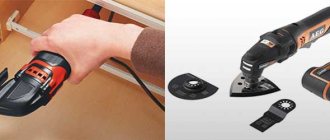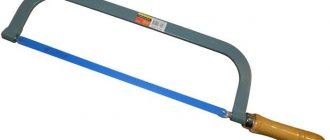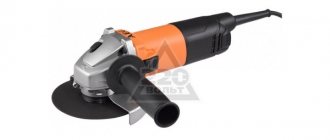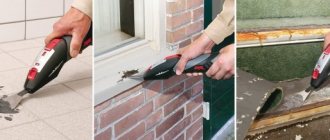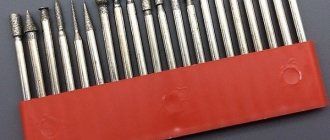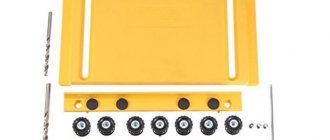SHARE ON SOCIAL NETWORKS
FacebookTwitterOkGoogle+PinterestVk
A hand hacksaw for metal is a special tool that is used for cutting metal workpieces, ceramics, wood, plastic, foam and organics. Today there are several varieties of such devices, which have certain characteristics and individual parameters. This article provides detailed information about the design features, types and rules for choosing a universal tool.
A hand hacksaw for metal is a carpentry tool
Types of hacksaws, characteristic features of products
A hacksaw is a carpentry tool; it is a type of saw. Its main purpose is to cut blanks and products made of different materials.
Metal hacksaws can be manual or electric
Saws are divided into manual tools and electric hacksaws. The latter option is equipped with a motor, which ensures fast and less labor-intensive work. This reciprocating hacksaw can be presented in the form of a corded or battery-powered tool. The first type of device operates from the electrical network. This hacksaw is quite a powerful device. Its only drawback is the presence of a cord, which limits the operating area.
Reciprocating tools can be divided into electric hacksaws for metal, wood and stone; their blades differ in length, shape, size and number of teeth.
A cordless hacksaw is a more mobile device that runs on a battery. This type of device is characterized by lower productivity. One battery charge is not enough to operate the tool for a long time.
Depending on the purpose, there are hand saws for wood and for metal. The first type of device consists of a working blade equipped with sharp teeth and a handle for comfortable grip. This tool is often used for cutting drywall and aerated concrete.
Hand saws can be used for both metal and wood
A hand saw for wood can be classic, circular or tenon. The first option is used for longitudinal or transverse cutting of the workpiece. The teeth of the blade have a triangular shape and are located in increments of 1.5-6.5 mm. To increase sawing efficiency, you should study information on how to sharpen a hacksaw.
A circular saw is used to cut curved parts, which is achieved thanks to a narrow blade with fine teeth, which can be located on one or both sides. A tenon jig is used to remove protruding grooves and tenons to obtain a clean cut.
A hacksaw for metal is a universal tool that can cut a workpiece made of any material, including plastic, wood, foam, aerated concrete, etc. The working blade of such saws has fine teeth, making the cut more accurate and clean. During operation, small chips are formed.
Hand hacksaw for metal: tool design
The tool for working with metal has a simple design. It looks like a bracket, between the ends of which the canvas is fixed in a tense position. The device consists of a frame, a cutting element and a handle.
Hacksaw design: 1 – stand; 2 – frame-holder; 3 – shank; 4 – handle
The frame is intended for fastening the canvas. It can be made of different materials. For cutting dense metal workpieces, frames made of high-strength composites are used. The design of an element is determined based on the conditions of its use. If you often need to make cuts in hard-to-reach places, you should purchase a small device that allows you to adjust the tilt of the blades.
The cutting part is represented by a thin steel strip. The blade is installed in the frame so that the teeth are on the opposite side of the handle. It is the most fragile element of the structure, so when making a cut you need to act especially carefully and carefully, since carelessness can lead to breakage of the product.
The cutting blade has wedge-shaped teeth. When choosing a device, you should pay attention to whether the cutters have been hardened, which increases the service life and productivity of the tool. This will also influence the solution to the question of how to sharpen a hacksaw (information can be found on the Internet). It is better to give preference to hardened, made of nickel-plated steel and having a dark color or bimetallic options, painted in any tone.
Important! For cutting hard products, you should choose blades with small cutters, and for soft workpieces, it is recommended to use a cutting element with large teeth.
Convenience and safety when using a hacksaw for metal is ensured by the handle
The handle is an important part of the tool, which ensures convenience and safety when using a hacksaw. The best is a two-component handle, which is equipped with durable rubber and special soft inserts. The handle can be placed on the side or on top of the hacksaw.
Recommendations
To select the appropriate tool, consider the following parameters:
• size – determined by the volume of work.
Compact products with a length of 150 mm are suitable for sawing small amounts of materials, since the hand gets tired quite quickly when working with such a jigsaw.
Standard saws with a length of 300 mm perform more work;
• tooth shape and sharpness;
• pitch – for sawing soft alloys, plastics, asbestos, large teeth with a pitch of 18 are suitable.
Hard materials are cut with fine-toothed hacksaws;
• material – the most durable and reliable today is a cloth made of different metals, the so-called bimetallic.
But if a blade is rarely needed, then the home craftsman can get by with a carbon steel model;
• cost – the nature of the fabric, the size and configuration of the teeth determines the price of the product.
Types of hand saws for metal depending on the area of use
The main purpose of a manual hacksaw for metal is to cut workpieces made of durable metals, cut seams and grooves, and trim products. This tool can also be used for sawing objects made of ceramics, wood, plastic, organics and foam.
Depending on the scope of use, hand hacksaws for wood and metal can be divided into three types: household, professional and handle hacksaws. The first version of the tool is intended for home use when solving simple problems. The models are distinguished by their simplicity of design and ease of operation. Such products are made in a wooden frame located longitudinally to the canvas and combined with a wooden handle. The cutting element is screwed to it using screws.
Professional-grade hand saws are equipped with a durable and comfortable rubberized handle, so the tool can be used for a long time. The cutting blade is set at a certain angle, which allows you to make cuts of unusual shapes. This type of tool makes it possible to create a variety of cuts in workpieces and is characterized by high quality construction and durability.
The frame for fastening the canvas can have different shapes
A hacksaw is similar in appearance to a staple. Thanks to this configuration, the tool can be used in hard-to-reach places, as is clearly shown in the photo of hacksaws for metal. This device is ideal for making internal cuts. The cutting blade is attached only on one side. There are folding versions of mini hacksaws for metal.
Blade options for a hacksaw for metal
Cutting blades for hand saws for wood and metal can be made from different materials. The most economical and lightweight option is a carbon steel blade. This blade is used for household saw models. It has a low cost and has a short service life.
Tooth blades with partial heat treatment are considered a more technologically advanced, wear-resistant and durable option. High-speed cutting elements are cobalt steel blades. Such fabrics are flexible and have fairly good strength. They are used for cutting hard workpieces. This ensures high quality and cutting speed. This option is also often used for electric hacksaws.
Hardened blades are suitable for directional cuts. It is advisable to use them for cutting at a certain angle.
Cutting blades for hand saws are made from various materials
Bimetallic sheets made from carbon steel produced by the cold-rolled method are distinguished by their high strength and reliability. A strip of high-speed steel on which the cutters are located is welded onto its surface using an electron beam method.
Cutting blades are classified according to the type of saw blade, which can be made along the blade or along the cutters. In the first case, the teeth are retracted from the edge of the file alternately to the left and to the right with a bend height of 2-3 mm and a deviation of 0.25-0.6 mm. This arrangement is typical for paintings with small incisors.
When setting along the incisors, the teeth of the blade are bent in different directions. Alternation is performed in accordance with the step size. With a small value, 2-3 incisors are retracted, with a medium value - 1 tooth to the left and 2 to the right, the remaining three are in place. For a large step, the retraction of the incisors is performed alternately.
Canvases are single-sided and double-sided. In the first case, the cutters are located on one side, and in the second they are on both sides of the blade.
To work with hard products, you should choose blades with small cutters
Canvas dimensions, length, width
The dimensions of the file are determined by the fastening method.
— Most models provide double-sided fastening.
For such products, canvases are available in only 2 sizes: 300 and 150 mm.
The first option is considered standard; products of this size are made of all possible types and from all acceptable materials.
The 150 mm long file is made only of carbon steel.
The thickness depends on the purpose of the tool.
On professional models, the value varies from 0.63 to 1.25 mm.
Blades for electric saws are thick - up to 2.5 mm.
— Blades for hacksaws, where fastening is only on one side, are made in lengths of 220 and 260 mm.
The height of the file reaches 13 mm. They are made only from a bimetallic alloy, since all other options are too fragile.
— For products with a pistol grip, blades can be of different lengths and thicknesses.
They are made only from bimetallic alloy.
Another important characteristic is the tooth.
Products with fine teeth are suitable for sawing hard metals.
The option with large ones is intended for processing soft ones.
They are not interchangeable.
Since when sawing soft metals with small teeth, the saw quickly becomes clogged with shavings, and the cut turns out to be sloppy and torn.
Non-standard types of hacksaws for metal
Diamond wire can be used to cut hard alloys, ceramics, stone, concrete and metal. The element is made of alloy steel, onto which a 2 mm layer of diamond coating is applied. At the ends of the string there are loops, which are intended for securing the product to the hacksaw frame.
Diamond thread is capable of cutting a workpiece efficiently, quickly and without much effort. Its work can be compared to a professional version of a hacksaw for metal. However, the cost of diamond string is much lower. The thread makes a cut of a solid workpiece with a depth of 1 mm in 1 minute. A glass product 0.5 cm thick will be cut in 40 seconds. A diamond string can cut a stone in 30 seconds with a cutting depth of 1 cm.
Important! For high-quality and convenient cutting of workpieces, the thread and material should be moistened before starting work, repeating the procedure during the process.
Another blade option for a hacksaw for metal, the price of which is much higher, is a steel thread. Its surface is coated with tungsten carbide. Products are produced in lengths of 300 mm and diameters of 2.7 mm. This thread is capable of performing high-quality, accurate and neat cutting of the workpiece. With its help you can make a curved or circular cut.
Hand hacksaws for metal can have not only a different cutting element, but also the very shape of the product
Teeth setting
Removal of chips from the cutting zone is carried out due to a certain layout of the cutting edge. As previously noted, according to this criterion, several options are distinguished:
- Wiring for each.
- Setting through one or two teeth.
At the same time, attention is paid to the direction of the teeth. Taking this parameter into account, the plate is installed.
Today, many tool manufacturers specialize in the production of hacksaw blades. At the same time, domestic products are much cheaper, foreign ones are more expensive, but at the same time have higher performance characteristics. For long-term operation, several products are required, as they can wear out at a high rate.
If you find an error, please select a piece of text and press Ctrl+Enter.
Basic criteria for choosing the right hand tool
When choosing a tool, you should be guided by certain characteristics of the elements. High-quality and reliable devices are made in accordance with the requirements of current GOSTs. A hacksaw for metal should be practical. It is necessary that cutting in any direction and at different angles be carried out easily and quickly.
Helpful advice! It is better to give preference to hacksaws that are capable of sawing metal not only with direct forward movements, but also with reverse ones.
The cutting blade can have different cutter shapes, which varies depending on the inclination of the gear element and varies between 0-10 degrees. The tooth pitch is selected based on the strength and thickness of the material to be processed.
It should also be taken into account that when working with a workpiece, no more than 3 teeth can simultaneously exert pressure on it, provided that the cutting is carried out at a right angle. To cut soft workpieces, it is enough to purchase a tool with a tooth pitch of 3.5 mm; for harder material, you will need a hacksaw, in which the cutters are located at a distance of 5 mm.
A hacksaw for metal should be characterized by convenience, practicality and reliability
The size of the blade is determined by the dimensions and volume of the workpieces being processed. The length of the cutting product can be 290-700 mm. When choosing a canvas, you should pay attention to its appearance. The element must be clean, smooth and able to return to its original shape after bending. The surface must not contain cracks, damage, traces of corrosion and other defects. The most popular is the 300 mm metal hacksaw blade.
Related article:
DIY metal cutting machine: manufacturing technology
Features of designs, preparation of tools, step-by-step technology for manufacturing machines based on a disc and an angle grinder.
Very reliable, safe to use and durable are saws whose handle is a solid element that does not have internal voids. Hollow options quickly fail. They break easily even with the slightest impact.
Helpful advice! When choosing a hacksaw, you should take the tool in your hand, and your palm should fit the handle quite tightly.
When buying a saw for metal, you should not give preference to too cheap options. At the same time, it is also recommended to avoid purchasing expensive models, since this is not always justified from the point of view of the optimal ratio of cost and quality of the tool. The average price of a hand hacksaw for metal is 600-1200 rubles.
When choosing a hacksaw, you need to take it in your hand, your palm should fit tightly around the handle of the tool
Which tooth to choose
The cutting plane for metal is made with different tooth sizes and different pitches.
The parameters are interrelated: the more spaces, the fewer teeth, and the fewer teeth, the larger they are in size.
The determining parameter is the number of teeth per linear inch (25 mm).
Products are available with 18, 24, 32 teeth.
The more teeth, the smaller they are, and the harder the metal the blade can cut through.
To process materials of different hardness, it is recommended to use files with a certain number of teeth.
Another nuance is the material of the teeth.
Hardened teeth are much stronger, more durable, and cut harder materials.
However, over time they also lose their sharpness.
Alas, it is no longer possible to sharpen them.
Regular teeth are restored to sharpness using a special saw file; this does not apply to metal blades.
Rules and features of working with a hacksaw for metal
To work with a hacksaw for metal, you do not need to have any special skills or abilities. However, when using the tool, certain rules must be followed.
Before cutting the workpiece, it is necessary to correctly insert the metal blade for a hand saw. First you need to straighten it in width. Then the ends of the canvas are installed on the seats and secured with nuts. Correct fastening eliminates the possibility of vibrations during use of the tool. The cutting element should ring with a click like a guitar string. However, do not over-tighten the nuts as this may cause damage.
Important! The optimal tension of the canvas is determined when it is first screwed to the frame without further intervention.
To minimize the likelihood of tooth blade breakage, the workpiece must be secured using a special vice. This measure will ensure the product remains in a stationary position, which will facilitate fast and high-quality cutting. The tool is installed on the workpiece at an angle of 30-45 degrees, which minimizes noise and vibration when cutting, creating the thinnest possible cut.
To work with a hand hacksaw for metal, you don’t need any special skills or abilities.
Cutting the workpiece at right angles across the metal is carried out in exceptional cases. In this case, the evenness of the cut will be determined by the smallest angle of inclination.
For the convenience and safety of using a hacksaw, the master needs to take the correct posture. For good stability when cutting, your feet should be slightly apart. The hand with the hacksaw must be held at a right angle. You need to ensure that the movements are calm and uniform. The first movement is made with little force, which allows the cutting blade to enter the workpiece rather than slide along the cut line.
The range of movements when making a cut should be maximum, reaching the edges of the workpiece. The arc of the hacksaw must not be allowed to come into contact with the workpiece. You should not use just one section of the cutting blade, as it will quickly fail. The arc should be positioned evenly, without tilting in different directions.
Important! Sharpening of hacksaws for wood and metal is not carried out, since the blades of such tools are equipped with small cutters, after abrasion of which it is necessary to replace the consumables.
To reduce the likelihood of blade breakage, the workpiece should be secured in a vice
Characteristics of a rotary miter box with a hacksaw
A rotary miter box with a hacksaw is represented by equipment consisting of a saw and an adjustable stand, with which you can adjust the cutting angle from 15 to 135 degrees. The miter box can be made of metal or plastic. The first option is used for cutting molded elements of small thickness, and the second - for a small amount of work.
A stand in the form of a miter box is used to give the instrument additional rigidity, while simultaneously acting as a limiter. A hacksaw with a blade equipped with small cutters can have a length of 290-600 mm.
When cutting a workpiece, the cutting element enters it at a certain angle, simultaneously in the vertical and horizontal plane. Thanks to this two-plane tool, it is possible to form a bevel at the end of the workpiece of any configuration.
A device with a rotating miter box is one of the best professional-type hacksaws for wood and metal. It is advisable to use it for carpentry work of increased complexity. The weight of the equipment is 2-4 kg. The price of a hacksaw for metal with a miter box is 2 thousand rubles.
The rotary miter box adjusts the cutting angle from 15 to 135 degrees
To operate such a tool, the frame must be secured to the working surface using self-tapping screws or a clamp. Markings should be applied to the workpiece to be processed indicating the cutting locations. The product is fixed on the miter box so that the mark coincides with the slots on the plate. Then you need to set the cutting angle degree and secure the hacksaw so that it works in the same plane. After this, the workpiece is cut.

